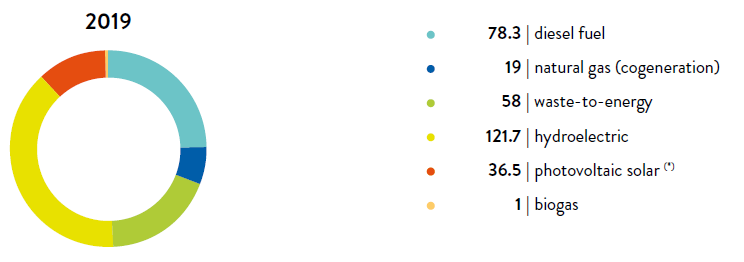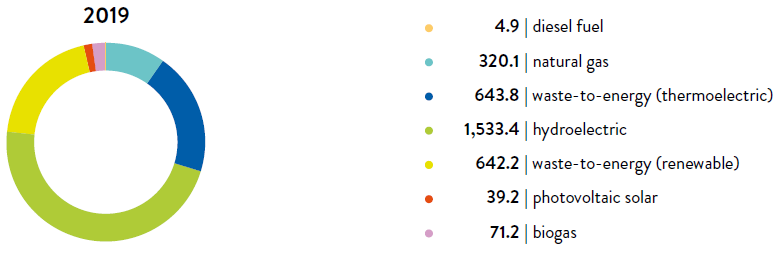Discover the Acea Group online 2019 Sustainability Report
Energy production: fossil and renewable energy sources
GROUP PLANTS
Acea produces electricity mainly through hydroelectric plants.
A significant share is produced by waste-to-energy of pulpers and Refuse-Derived Fuel – RDF, a primary energy source derived from waste, both with shares equal to about 50% of biodegradable material.
Generation from renewable sources (hydroelectric and photovoltaic, with the exception of waste-to-energy) and from fossil fuels (thermoelectric) – the latter mainly through the high-efficiency cogeneration plant – is entrusted to Acea Produzione.
The inventory of generators available to the Company consists of:
- 7 hydroelectric power stations located in the Lazio and Abruzzo regions for a total of 122 MW;
- 2 thermoelectric power stations located in the territory of the Municipality of Rome: Montemartini (78.3 MW) and Tor Di Valle (19.0 MW), for 97.3 MWe total installed power available;
- A photovoltaic park, for a total of 36.5 MWp, of which 28 MW acquired in the second part of the year.
The Company Acea Ambiente ensures the generation of energy from waste-to-energy with two waste-to-energy plants located in San Vittore del Lazio and Terni.
The total gross electrical power currently available is equal to about 58 MWe.
In addition, Acea Ambiente produces electricity using biogas derived from the anaerobic digestion process.
TABLE NO. 46 – INSTALLED POWER OF THE ELECTRIC POWER STATIONS OF ACEA PRODUZIONE
| hydroelectric power stations | thermoelectric power stations |
| Castel Madama power plant (Rome) gross power 9.4 MW | Tor di Valle power plant: high efficiency cogeneration section (CAR)(*) (Rome) methane fuel – gross power 19.0 MW |
| G. Ferraris power plant in Mandela (Rome) gross power 8.5 MW | Montemartini (Rome) power plant diesel fuel – gross power 78.3 MW |
| Salisano (Rieti) power plant gross power 24.6 MW | |
| G. Marconi power plant in Orte (Viterbo) gross power 20.0 MW | |
| Sant’Angelo (Chieti) power plant gross power 58.4 MW | |
| Cecchina (Rome) power plant gross power 0.4 MW | |
| Madonna del Rosario (Rome) power plant gross power 0.4 MW | |
| general total: gross capacity 219 MW | |
(*) The CAR plant in Tor di Valle provides district heating service in the area south of Rome.
The installed capacities, which overall amount to about 315 MW105, are represented in chart no. 45, distinguished by energy source.
CHART NO. 45 – INSTALLED ELECTRICAL POWER OF THE GROUP BROKEN DOWN BY ENERGY SOURCE (MW)(2019)

(*) Photovoltaic MW under the responsibility of Acea Produzione also include 28 MW acquired in the second half of 2019. The energy produced by the new plants will be reported from 2020.
ELECTRICITY PRODUCED
In 2019, the total gross production of electricity decreased to about 904 GWh, -7% compared to 968 GWh last year due to the low rainfall, which reduced hydroelectric production, and some problems related to the line turbines of the waste-to-energy plant in San Vittore del Lazio which, in addition to the postponement of the plant’s maintenance (due to the regional ordinances put in place to overcome the waste emergency in Rome), resulted in less positive energy performance than planned.
The share of electricity generated by renewable sources, about 635 GWh, has proven to be predominant and equal to about 70% of the total, with the following contributions:
- 426 GWh from hydroelectric power,
- 178 GWh from waste-to-energy,
- 20 GWh from biogas (Orvieto plant),
- 11 GWh from solar panels (see chart no. 45 and table no. 47).
Acea Produzione has continued to modernize and improve the efficiency of its hydroelectric plants. After the works carried out in previous years at the Guglielmo Marconi, Salisano and Alessandro Volta power plants in 2019, revamping continued on the Galileo Ferraris hydroelectric plant in Mandela, also located in the province of Rome, which will end in January 2020, making it possible to optimize the use of available water resources, under the same conditions of installed and licensed power.
With regard to the share of green energy from waste-to-energy, about 50% of the production from this type of plant is renewable, being associated to the combustion of the biodegradable fraction of waste used as a primary source. In particular, the renewable share of the fuel (RDF) entering the San Vittore del Lazio plant was equal to 51% of the total of waste-to-energy, while in the Terni plant this share was around 47%.
CHART NO. 46 – ELECTRICITY PRODUCED SUBDIVIDED BY PRIMARY ENERGY SOURCE (TJ) (2019)

NOTE The values reported in the chart are expressed in TJ (1 GWh=3.6TJ).
TABLE NO. 47 – ELECTRICITY PRODUCED (BY PRIMARY ENERGY SOURCE) (2017-2019)
| 2017 | 2018 | 2019 | |
| PRIMARY ENERGY SOURCE | TJ (GWh) (*) | ||
| diesel fuel | 7.7 (2.2) | 2.0 (0.6) | 4.9 (1.4) |
| natural gas (cogeneration) | 135.2 (37.6) | 261.9 (72.8) | 320.1 (88.9) |
| waste-to-energy (about 50% of the total) | 682.9 (189.7) | 718.4 (199.5) | 643.8 (178.8) |
| total thermoelectric | 825.8 (229.4) | 982.3 (272.9) | 968.8 (269.1) |
| hydroelectric | 1,369.7 (380.5) | 1,715.5 (476.5) | 1,533.4 (426.0) |
| waste-to-energy (about 50% of the total) | 700.2 (194.5) | 684.6 (190.2) | 642.2 (178.4) |
| biogas | 78.7 (21.9) | 67.1 (18.6) | 71.2 (19.8) |
| photovoltaic solar (**) | 41.7 (11.6) | 36.7 (10.2) | 39.2 (10.9) |
| total renewables | 2,190.4 (608.4) | 2,503.9 (695.5) | 2,286.0 (635.0) |
| general total | 3,016.4 (837.9) | 3,486.2 (968.4) | 3,254.8 (904.1) |
(*) 1 GWh = 3,6 TJ.
(**) Photovoltaic includes the production at the plants of the water area (Acea Ato 2) and at the waste management plant of Orvieto, for a total of 2 GWh produced. The energy produced by the plants acquired in the second half of 2019 will be included in the next report.
The decrease in energy produced by hydroelectric power plants, equal to about 10.6% compared to 2018, is due to the lower rainfall recorded during the year.
With regard to thermoelectric energy, the increase in production is due to a greater availability of the Tor di Valle plant.
THERMAL ENERGY PRODUCED
In 2019 Acea Produzione continued the project of extending the district heating network of Mezzocammino district in the zone South of Rome.
The Tor di Valle thermoelectric power plant generated about 96 GWh of thermal energy. The heat generated was used to serve 40,054 inhabitants in the zone south of Rome (Mostacciano, Torrino and Mezzocammino) by means of a district heating network which sever a volume equal to 3,651,124 cubic metres106.
In addition to the management described above, the Group operates Ecogena which, certified as an ESCo (Energy Services Company) in accordance with UNI CEI 11352:2014, develops the energy efficiency initiatives for the Group and reports their results to Gestore dei Servizi Energetici (GSE) for the awarding of Energy Efficiency Certificates (EEC).
The activities assigned to Ecogena include also the design and building of trigeneration plants107 for the production, in combined mode, of electrical, heat and cooling energy.
In 2019 cogeneration plants were managed, combined with district heating networks for a total of 5 MW of electrical power. The production of thermal and refrigeration energy is increasing compared to previous years, while there is a slight overall decrease in electricity production (see table no. 48).
TABLE NO. 48 – THE PRODUCTION OF ENERGY BY ECOGENA PLANTS AND ENERGY EFFICIENCY CERTIFICATES EEC (2017-2019)
| 2017 | 2018 | 2019 | |
| ENERGY PRODUCED | TJ(GWh) | ||
| electricity | 61.9 (17.2) | 54.1 (15.0) | 51.5 (14.3) |
| of which plants owned by Ecogena | 56.7 (15.7) | 50.3 (14.0) | 49.0 (13.6) |
| of which plants owned by third parties | 5.1 (1.4) | 3.9 (1.1) | 2.7 (0.7) |
| thermal energy | 90.4 (25.1) | 95.4 (26.5) | 103.3 (28.7) |
| of which plants owned by Ecogena | 74.8 (20.8) | 81.1 (22.5) | 89.2 (24.8) |
| of which plants owned by third parties | 15.7 (4.4) | 14.3 (4.0) | 14.0 (3.9) |
| refrigeration energy (all owned plants) | 17.0 (4.7) | 34.5 (9.6) | 37.6 (10.5) |
| EECs | |||
| Total EECs (all from plants owned by Ecogena) | 1,039 | 1,359 | 954 |
NOTE The topic of EECs is dealt with in the Energy savings section of the chapter The use of materials, energy and water.
106 The data is from August 2019.
107 Cogeneration, i.e. the combined production of electrical and thermal energy, allows high efficiencies to be achieved, between 80 and 90%. Trigeneration, which is a special application of cogeneration, allows use of a part of the thermal energy recovered in order to produce cooling energy in the form of cooled water for air conditioning in rooms or for industrial processes.